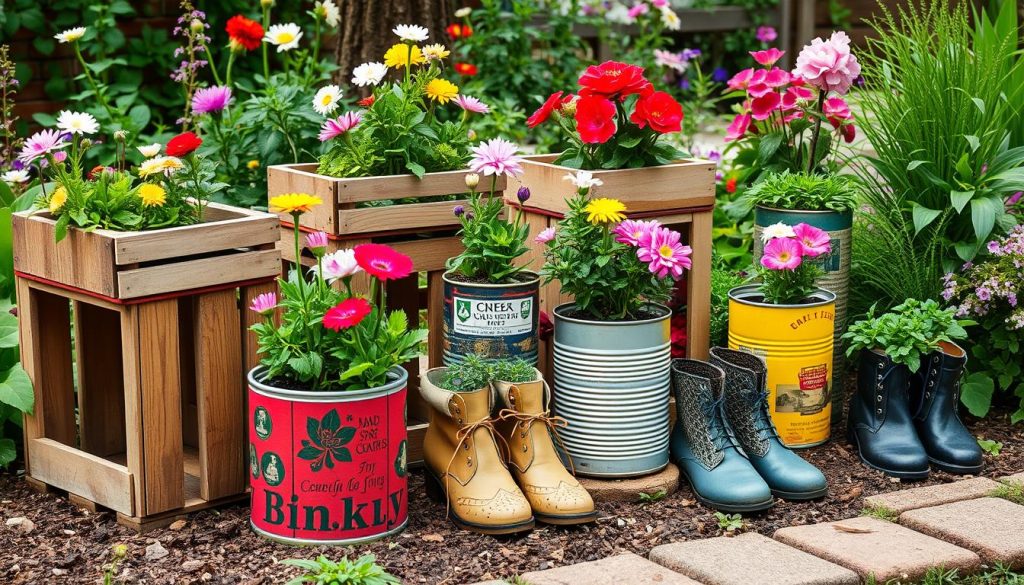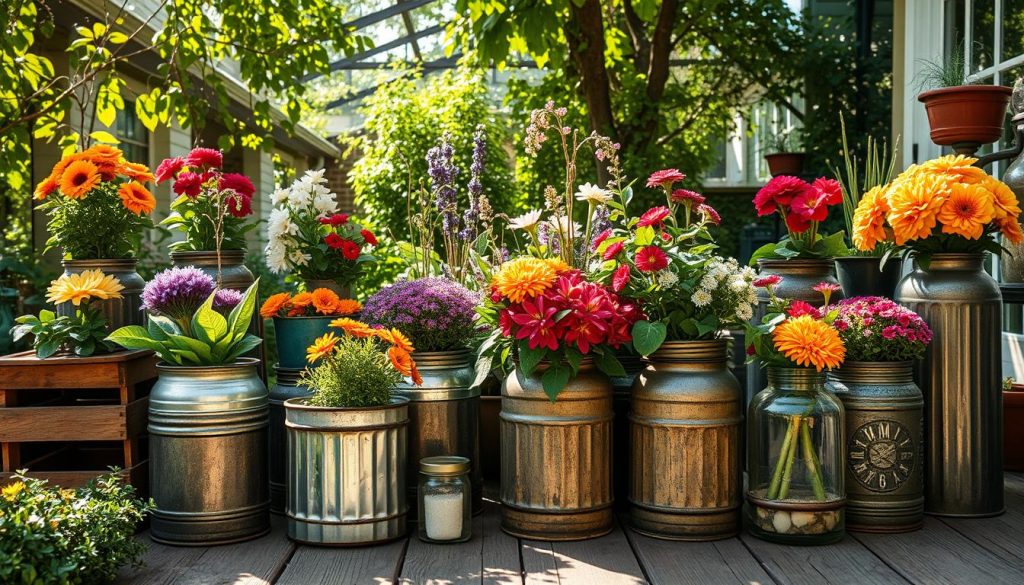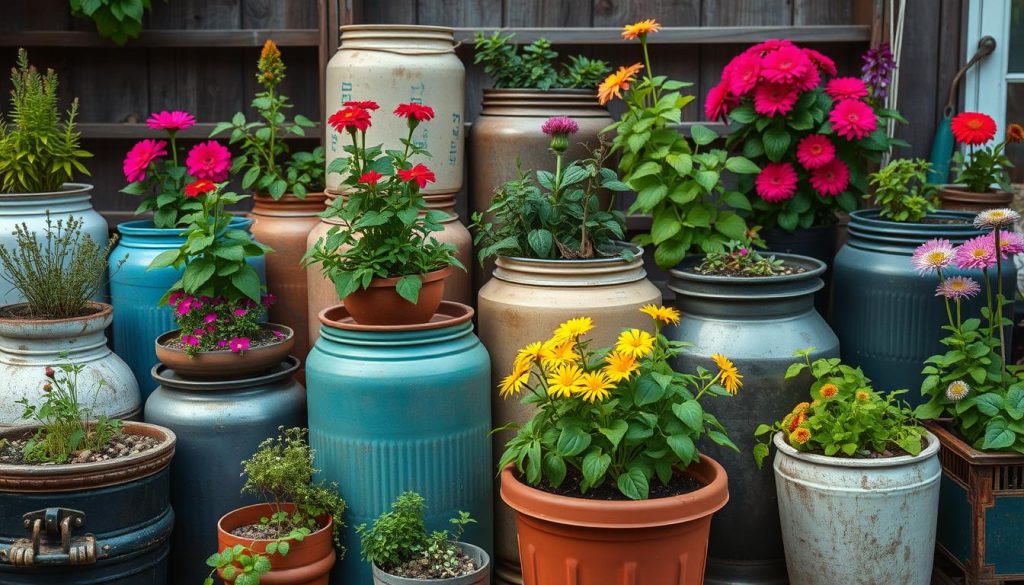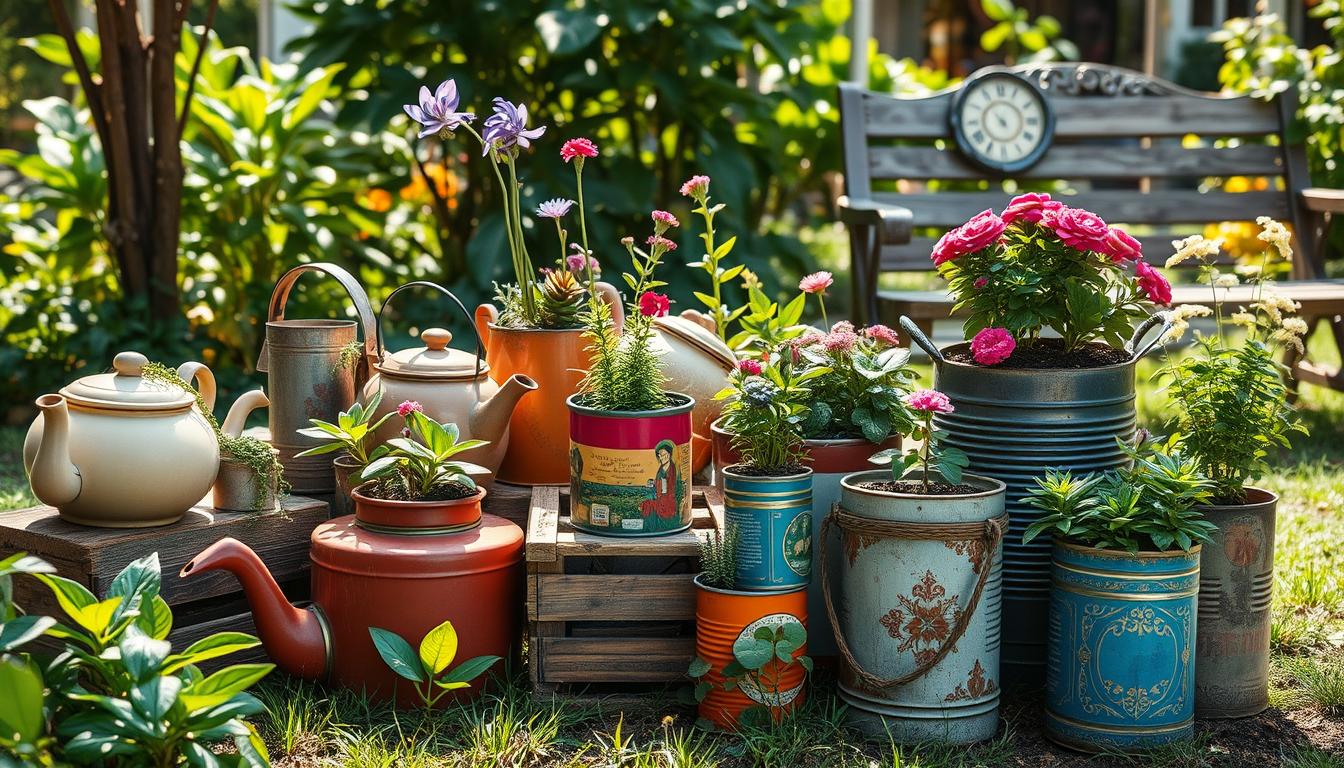I’m excited to share my experience with repurposing old containers for gardening. It’s become a fun and creative hobby for me. By using old containers, you can make unique and functional planters that add a personal touch to your garden.
This approach is not only eco-friendly but also budget-friendly. It involves upcycled container gardening.
In this guide, I’ll share creative container gardening ideas. I’ll also give tips on how to transform old containers into charming planters. Whether you’re a seasoned gardener or just starting out, you’ll find inspiration and knowledge here.
Why Repurpose Containers for Gardening?
Exploring gardening, I found that using old containers is creative and beneficial. It helps reduce waste and saves resources. This method makes my garden unique and eco-friendly.
Repurposing containers also helps the environment. It keeps materials out of landfills, lowering my carbon footprint. This way of gardening supports a sustainable future.
Benefits of Using Old Containers
- Reduced waste and conservation of resources
- Unique and personalized garden designs
- Cost-effective alternative to traditional gardening methods
Environmental Impact of Repurposing
Using old containers for gardening is good for the planet. It reduces waste and supports a sustainable environment. This way, I can have a beautiful garden and help the planet.
Cost-Effectiveness of Container Gardening
Another plus is the cost savings. Using recycled materials means I spend less on gardening supplies. This makes gardening affordable and eco-friendly.
Choosing the Right Containers
Choosing the right containers is key for a thriving container garden. There are many innovative ideas out there. Consider using recycled materials like old plastic bottles, wooden crates, or cardboard boxes. These are eco-friendly and can make your garden stand out.
Using reclaimed containers is a smart way to garden sustainably. Old pallets, buckets, or even a bathtub can be used as planters. Think about the plants you want and the space you have. Make sure containers have holes for drainage to avoid waterlogged soil.

Types of Containers to Consider
- Plastic containers: lightweight and easy to clean
- Wooden containers: natural and rustic, but may require maintenance
- Clay containers: breathable and moisture-wicking, but can be heavy
Materials to Avoid
Stay away from containers made from treated wood or plastic with BPA. These can harm your plants and the environment. Choose non-toxic and sustainable materials instead.
Assessing Drainage Needs
Good drainage is essential for healthy plants. Ensure your containers have holes in the bottom for excess water. Adding gravel or sand can also help with drainage.
Preparing Containers for Planting
To make a container garden thrive, you must prepare your containers well. It’s more than just adding soil and plants. Simple tips can help your plants start strong. First, clean and sanitize your containers to remove dirt and chemicals.
When using recycled containers, think about making your garden look good. Use old boots, wooden crates, or plastic containers for unique planters. Drill holes in the bottom for drainage to prevent waterlogged soil.
Creating healthy soil is key. Mix soil, compost, and organic matter for a good environment. These steps and tips will help you make a beautiful container garden.
- Clean and sanitize your containers
- Add drainage holes to prevent waterlogging
- Layer soil, compost, and organic matter for healthy soil
Preparing your containers well will reward you with a lush garden. These tips are great for all gardeners, whether you’re new or experienced. They’ll help you create a stunning garden that shows off your creativity.
Creative Ideas for Container Choices
Exploring upcycled container gardening opens up a world of creativity. It’s not just about saving the planet. It’s also about making your garden truly yours. Sustainable gardening with repurposed containers is both fun and rewarding.
Choosing containers is a breeze with so many options. Old kitchenware, like colanders or pots, can become unique planters. People also turn furniture, like wooden chairs or tables, into garden features. Thrift stores are full of hidden gems for planters.
Using Kitchenware in the Garden
Kitchenware can add a quirky touch to your garden. Here are some ideas:
- Old colanders or strainers for whimsical planters for herbs or succulents
- Teapots or coffee pots for elegant garden decor
- Metal or wooden spoons as unique trellises or plant markers

Repurposing Furniture as Planters
Furniture can be transformed into stunning garden features. Consider these ideas:
- Old wooden chairs or benches for planters or garden seats
- Tables or shelves for tiered planters or displays
- Wicker or rattan furniture for a natural, earthy look
The secret to upcycled container gardening is to think creatively and have fun. Don’t worry if things don’t turn out perfectly. It’s about enjoying the journey and creating something beautiful and sustainable.
Plants That Thrive in Containers
Choosing the right plants is key when using old containers for gardening. Container gardening tips and tricks help make even small spaces bloom. With creativity, old containers can become stunning planters for herbs, flowers, and veggies.
Herbs like basil, mint, and rosemary are perfect for containers. They’re easy to care for and add flavor to many dishes. For flowers, petunias, geraniums, and begonias bring color and life to your garden. Tomatoes, cucumbers, and carrots are also great for growing in containers.
With creative ideas, your container garden can reflect your personality. Lettuce, spinach, and radishes are also great for containers. They grow quickly and can be ready to eat in just a few weeks. The right plants and creativity can turn any container into a lush garden.
- Basil and mint are great herbs for container gardening
- Petunias and geraniums are perfect for adding color to your garden
- Tomatoes, cucumbers, and carrots are great vegetables for repurposed containers
Make sure to pick plants that do well in containers. Follow care tips to keep your garden thriving. With practice and patience, your container garden will flourish, giving you fresh produce and beauty all season.
Maintenance Tips for Potted Plants
To keep your DIY recycled container gardens thriving, proper maintenance is key. Watering is a critical part of caring for your plants. It’s important to find the right balance to avoid harming your plants.
Consider the material and size of your container when deciding on watering. This will help you find the best schedule for your plants.
For gardening with reclaimed containers, fertilizing and soil health are also crucial. Natural fertilizers like compost or manure can help promote healthy growth. Here are some tips to keep in mind:
- Water your plants when the soil feels dry to the touch
- Use a well-draining potting mix to prevent waterlogged soil
- Fertilize your plants regularly, but avoid overfertilizing

Another important aspect of maintenance is pest management. Regularly check your plants for pests. Use natural pest control methods whenever possible. By following these tips, you can keep your container garden healthy and thriving. Enjoy the benefits of your DIY recycled container gardens and innovative garden container ideas.
Seasonal Adjustments for Container Gardens
As the seasons change, it’s key to adjust your container garden. This ensures it keeps thriving. Sustainable gardening with repurposed containers needs attention to weather changes. A few simple adjustments can keep your eco-friendly garden thriving all year.
Preparing for Winter Months
To get your containers ready for winter, bring them inside or protect them from harsh winds and frost. This is crucial for upcycled container gardening, as materials can be more prone to damage.
Refreshing Plants for Spring
In spring, refresh your plants by repotting them in fresh soil and giving them enough sunlight. This will help your sustainable gardening with repurposed containers start strong.
Summer Care Tips
In summer, ensure your containers get enough shade and water. This prevents overheating and keeps your eco-friendly container gardening healthy.
By following these seasonal tips, your container garden will stay healthy and vibrant all year. Always use sustainable and eco-friendly practices, like upcycled container gardening, to lessen your environmental impact.
Sharing the Joy of Container Gardening
Container gardening is a fun hobby that brings people together. It’s great for spending time with family, friends, and the community. Sharing our gardening projects creates lasting memories and shows off the beauty of our creations.
Involving Family and Friends
Host a “container gardening party” with your loved ones. Pick out unique containers and colorful plants together. Decorate your outdoor space to make it special. This activity builds connections, sparks creativity, and shows love for container gardening.
Community Gardening Ideas
Join a local community garden or start your own. Share tips and tricks for repurposing old containers with your neighbors. This can inspire others to join the creative container gardening movement and help reduce waste.
Showcasing Your Container Creations
Post pictures of your container garden on social media or enter local contests. Showcasing your repurposed container gardening ideas can motivate others to try this eco-friendly hobby.

